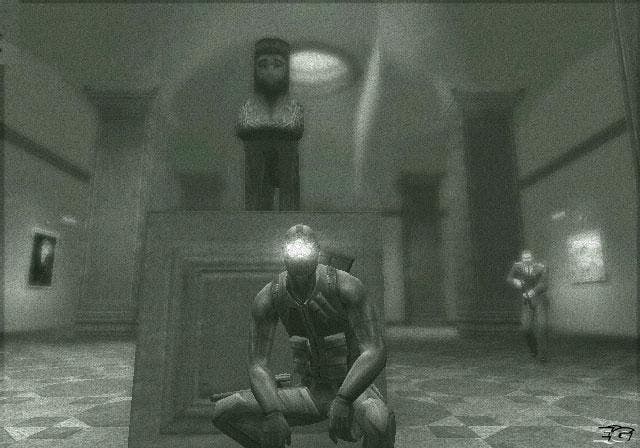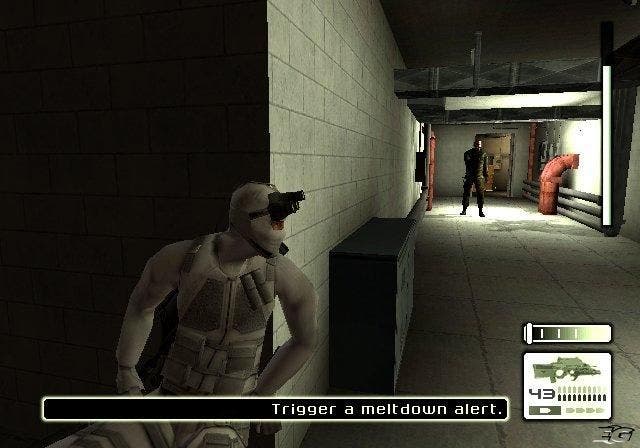Splinter Cell
Shanghai Surprise: Kristan couldn't believe his eyes
Even the most die hard PS2 owner must have been feeling a little envious when Splinter Cell burst onto the Xbox scene at the tail end of last year. Even though a port of the stealth action title was always on the cards, the feeling among the community was that the chances of replicating the visual quality were extremely slim. After all, those truly impressive lighting and texture effects had pushed the Xbox into new territory - how on Earth could the relatively humble Sony machine ever hope to compete.
Even the recent emergence of some PS2 screen shots failed to sway the generally held opinion that while the gameplay might make it intact, some compromises had been made. But, as all publishers do, Ubi stuck to its guns and promised us that the PS2 would be far more faithful to the original than anyone could imagine. Yeah yeah, pull the other one, we snorted, expecting the reality gap to be as wide as it usually is.

Still not convinced
But late last week Eurogamer was invited to a hotel suite in South West London to go and see for ourselves. As luck would have it, despite the short notice we squeezed it into our tight schedule and bombed down there - still living in hope more than expectation that it would be worth the effort. After exchanging pleasantries with our genial host Gregoire Gobbi, Ubi Soft executive veepee, he explained how the conversion had come together: "Ubi Soft has a studio in Shanghai that specialises in the PS2, and we assigned around 70 people to do the job. We then sent over 10 people from Montreal and a few from our French offices to oversee the level design and overall polishing."
He explained that the Xbox version was essentially rushed out on Microsoft's insistence (commercially a wise decision as it turned out), but that the extra development time had given Ubi Soft a "huge benefit" in allowing it the opportunity to rectify some of the niggles that existed in the original. "We've changed the control system, smoothed the difficulty curve and given it a better narrative flow."
The most obvious addition is the cut scenes - something that wasn't sorely missed from the original, but now they're there, it helps give the missions context. "We hired a director from Hong Kong, Florent Emilio Siri to give the game a proper 3D introduction, which I think helps set the scene far better. We've also introduced cut scenes to the start of each level, and they help to explain the storyline much better; we're very pleased with the results." Indeed, having just sat through several of them, we can testify that the previously rather bolted on storyline now makes much more sense, and lends the package a more rounded, coherent feel. Round one to the PS2.

Microsoft's loss is Sony's gain
Also added to the PS2 version - exclusively - is the Power Plant level, which appears midway through the game. "It was meant to be in the Xbox version," he admitted, "but we ran out of time and had to cut it." But will this level remain a PS2 exclusive, or end up on future versions at a later date? "It's definitely PS2 only," he nodded. Round two to the PS2.
What of the controls? Many of you who have played Splinter Cell previously will no doubt have found the inventory management system unwieldy, with players forced to go through hoops to use the lock pick or the optical camera to peek through keyholes. This has been emphatically addressed, with a new context sensitive system allowing the player to automatically select essential pieces of equipment as and when they're required, rather than having to press the black button, scroll left, left, left, select the item and then use it. What was fiddly as hell previously is now a breeze, and the game's instantly more playable because of it.
And talking of playability, Gobbi admitted the Xbox could be a real git at times: "We've smoothed the playability in the PS2 version. There were obviously a few red spots that caused gamers real problems. We looked at those areas and where possible made the game more playable." After a quick scout of the first level, this claim was easy to verify, with certain sections, such as the first flaming staircase now accessible, whereas before, players would be forced to clamber over the top banister. The smoke filled room that required you to shoot out the skylight no longer requires you to use your night vision. Likewise, the first area after the fire used to require a quick jump between buildings. Not any more. A handy pipe just further up now allows you to shimmy across. Hmmm. We're not necessarily convinced the PS2 version needed to be 'dumbed down' like this, but we do agree the Xbox version could be unforgiving and downright hardcore on occasions. Mixed feelings here, but if you're going to appeal to the mass market, keep them constantly entertained… time to move on.

Do not underestimate the power of the PS2
So what about the visuals? Well, we thought we'd save the best 'til last, because we're a bit taken aback. To say that the PS2 version is on a par with the Xbox version is no exaggeration, and is truly one of the finest feats of coding we've yet witnessed. All the texturing, lighting and effects have been replicated with impressive authenticity - although it came at a price. With a 70 strong team working on the conversion, this was almost double the number that put together the game in the first place. There are, of course, plusses and minuses. On the plus side, there's now an impressive heat haze effect when you're in front of the flames, while the objects, scenery, character models, and lighting effects look just as impressive as previously. The one minus point we noticed so far was the rather weak flame effects. One of the best bits of the first level on the Xbox was the feeling that you were being roasted alive, with exploding set pieces adding huge dramatic impetus. Not only do the flames now look a bit lame in comparison, the sense of a building about to fall around your ears is just not there anymore. Bah. Honours: even.
Meanwhile, the lack of hard disk caching means that every check point now demands a fairly lengthy load, although we'd guess at no more than 30 seconds, which is just about acceptable.
So how did the Shanghai team replicate the native shadow buffering of the Xbox? "In basic terms they came up with a software solution called Shadow Casting," he offered. Whatever it is, it does the job just as well. Elsewhere, Ubi has come up with some other technical firsts; this time in its handling of the audio. "We managed to triple stream audio off the DVD, which we don't think anyone else has managed on the PS2 - we've got sound effects, music and the voices streaming all at once, meaning no loss of ambience."
Unconvinced? There's a demo on the way
If you're still not convinced, perhaps it's as good a time as any to point out that the Official PS2 Magazine has Splinter Cell as its lead demo this month - available fully five weeks before the game's March 28th release. A playable one level demo is also on its way to EG by the end of the week, and we fully expect it to deliver one of the most welcome surprises that PS2 gamers will have seen, and serves to create a new high water mark for visual excellence on the PS2, and unquestionably the finest stealth action title on the platform, by a mile.
Splinter Cell screenshots (PS2)
Splinter Cell screenshots (Xbox)
Splinter Cell screenshots (GBA)
Splinter Cell review (Xbox)
Splinter Cell first impressions (PC)




.png?width=291&height=164&fit=crop&quality=80&format=jpg&auto=webp)



